Ah, Paris! The City of Light, love, art and beauty. But Paris has its dark side, too, which serves as an integral part of the setting for Ann Jacobus’ powerful and gripping debut young adult novel, Romancing the Dark in the City of Light. This week, Ann discusses how we can use setting to shape and strengthen our stories, to reveal character and increase tension. All of this is expertly done in Ann’s novel where the setting serves not only as the backdrop to this thrilling and emotional story, but almost as a character itself. It’s my pleasure to host on WRITE NOW the talented and lovely and certainly full of light…Ann Jacobus.
Setting as a Workhorse (named Paris)
Setting sometimes gets short shrift. For realistic fiction, this is especially true. Just pick an actual place or two, and the better you know them, the more effectively you can use them. Right?
Right. But odds are high that you can make your setting work harder.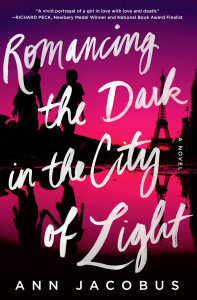 Our macro setting(s) provide—in addition to the geographical location—the historical period, and the time of year and day, and the culture within which your story takes place.
Our macro setting(s) provide—in addition to the geographical location—the historical period, and the time of year and day, and the culture within which your story takes place.
Micro setting is where each scene takes place. A good macro can provide lots of good micros, which in turn add energy, texture and tension.
If you’re writing SF/fantasy, you will be building all this from scratch, and kudos to you.
My YA thriller Romancing the Dark in the City of Light is set in Paris, a city I love. My family and I lived there for many years and I wasn’t exactly the first one to realize it would be a cool setting for a novel.
I also knew my story was going to be contemporary, or “modern day,” so that took care of macro-time. My main character would be an American who is part of the expatriate culture—foreigners abroad. But how could I work against the cliché of an American in the same old, awesome, romantic Paris (yawn)?
Paris has a huge population of ex-pats. After we arrived, I noticed that a number of “trailing spouses,” meaning the husband or wife who doesn’t have the ex-pat job, were surprisingly not so happy to be there, or at least at first. Moving anywhere, adjusting to a new culture, and trying to operate there—especially if you lack language skills, not to mention friends and family in the area—can be emotionally as well as physically trying. This is true anywhere.
But when you’re in Paris, no one back home has much sympathy for you.
A couple of these poor sods found dealing with French bureaucracies and services, and the different cultural values so overwhelming they went back to the US or other home countries. Paris for them was a hostile punishment zone, not a prize.
This got me thinking.
I had an idea about a depressed, ultimately suicidal girl. How would this incomparably beautiful and culturally rich city look through the eyes of such a protagonist? Not so nice, right?
My MC is drawn to the underbelly of the city, and dark and creepy places (https://www.playbuzz.com/griffinteen10/the-dark-side-of-the-city-of-light-top-10-creepy-places-in-paris) are a reflection of her inner state. So now, timing is decided, too. Naturally the story should take place at the coldest, darkest part of the year. Cue overcast skies.
Summer notices the hookers, the homeless, lonely children, Romany beggars, and old chewing gum on the floor of the train. She visits a graveyard, the catacombs, the sewers, and in these places, she focuses on things that remind her of death.
Poet and writer Nam Le says, “The subjectivity through which we see things is THE most important part of the thing that’s being seen.”
Setting is an often-under-used tool of great power. It can be a subtle—or not so subtle—mirror, reflecting metaphors or objective correlatives that reveal so many things about our character(s). Of which we’re then relieved of the need to tell our readers. A rich setting provides fodder to work against expectations, to avoid clichés, and to provide energy-generating contrast.
How can you mine your setting to reveal more information about your characters and tension for your scenes?
- Macro: think like a low-budget movie producer. Or a high-budget scout. What locations (that you know or research) will give you the most interesting exterior shots? And the potential for interesting interiors? Your story takes place in a town in Tennessee. Instead of in Toone where you grew up, can you set it in Memphis on the banks of the Mississippi and use Graceland for something? You’ve been there, but go visit and take fresh notes.
- Micro: In fiction for younger readers we’re often obliged to use characters’ abodes and schools. Question this assumption. Where else in your macro setting could you place this scene? It may have to be at school. If so, stretch yourself out of the classroom or the cafeteria! And all family scenes do not have to be in the kitchen. What about the local farmer’s market, the little brother’s ballet studio, an e-cigarette shop? Better yet, get your character into an uncomfortable place like traffic court, or the gynecologist’s office with their sister, where they would otherwise not go.
- Details that reveal the POV character: Try brainstorming a long list of objects that are somehow like your character, (a vase with cracks, a car with horsepower, a stuffed turkey) and then find a way to have your character focus on one or two during a scene. I trust you to do this where it’s appropriate.
Good Luck!
GIVEAWAY! Ann is offering a copy of her novel, Romancing the Dark in the City of Light to readers from the U.S. and Canada. Comment on the post for a chance to win!
A Texas native who spent her childhood in Arkansas, Ann Jacobus is the author of YA thriller, Romancing the Dark in the City of Light (St. Martin’s Griffin, October 2015). She earned an MFA in Writing for Children and Young Adults from Vermont College of Fine Arts, and lived overseas with her family for almost two decades. San Francisco is now home.

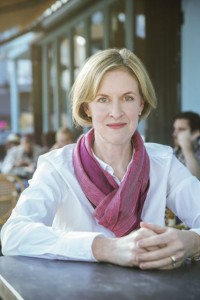
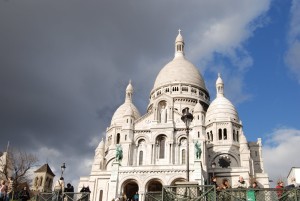
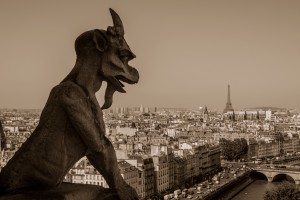

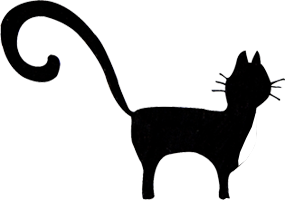
🙂 I love everything about this in depth look at place and setting and point of view. I desperately hope Summer makes it out the other side–holds on to a glimmer of light in the dark.
I’ve only been hearing good things about this one, Ann. Thanks for writing it.
Thank YOU, Erin!
I love the idea of looking at a setting from a particular – emotional – point of view.
I am so looking forward to reading this!
xo
Sarah